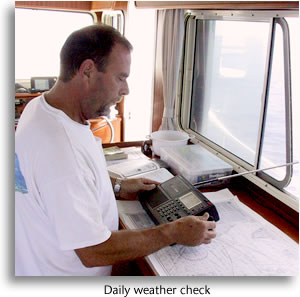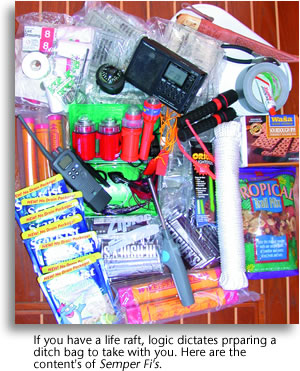|
Weather
 About a week before our scheduled August 19 departure, I began monitoring the website for the Navyís Fleet Numerical Meteorological and Oceanography Center (FNMOC)-www.fnmoc.navy.mil/-which publishes weather forecast maps out 144 hours. The one I like the best is the Wave Height and Direction map, which tells me almost everything I need to know before setting out to sea. Additionally, NOAH publishes its NMN forecasts at www.nws.noaa.gov/om/marine/hfvprod.htm, and the Bermudan governmentís Rescue Coordination Centre publishes excellent Atlantic forecasts at www.rccbermuda.bm. About a week before our scheduled August 19 departure, I began monitoring the website for the Navyís Fleet Numerical Meteorological and Oceanography Center (FNMOC)-www.fnmoc.navy.mil/-which publishes weather forecast maps out 144 hours. The one I like the best is the Wave Height and Direction map, which tells me almost everything I need to know before setting out to sea. Additionally, NOAH publishes its NMN forecasts at www.nws.noaa.gov/om/marine/hfvprod.htm, and the Bermudan governmentís Rescue Coordination Centre publishes excellent Atlantic forecasts at www.rccbermuda.bm.
The navy color codes its ocean maps to differentiate for wave heights, the best color being dark blue, which signifies a prediction of 1 to 3-foot seas. The week before our trip the Atlantic was painted dark blue from Jacksonville to Lisbon and everything in between. But the blue was predicted to begin shrinking with bigger seas forming along our route. The best news, of course: Not a tropical storm in sight despite Hurricane season.
Safety
To me safety is an annoyance; more accurately, the subject of safety that annoys. Everything Iíve written so far about this trip touches on the subject of safety, but, unfortunately, the world has come to see safety not in terms of preparation, skill and experience, but as a list of products. Iíve got no problem with Coast Guard-mandated bells, whistles and flares, and our 406 Epirb makes darned good sense, but I always shake my head at liferafts. From my sailing days, I remember folks spending thousands on a new raft when what they really needed for safety was a new engine or rigging.
But the experts say, Thou shalt carry a liferaft. Why, I ask? The Great Harbour N37 is unsinkable because it has no ballast and its decks and superstructure are built with highly buoyant Nida Core. Semper Fi is its own liferaft; fill it with water and it will still float. Plus, no one has ever been able to tell me how many people in the whole world are actually rescued in liferafts any given year. Tens of thousands of rafts are sold annually; how many are actually deployed in a life or death situation? Five? Two? One?
So did we ship a liferaft? Yes, of course we did, begrudgingly. Didnít want to be accused of recklessness. There was, we admitted, a minute chance that fire could force us over the side.
 We sent our factory raft, a Plastimo 8-man offshore, off to be repacked and put it aboard. The cost of the repacking was $750, because even though the raft itself was in good shape, most of its contents such as first aid kit, water, etc had expired. I wish the raft people would produce a barebones product-just a raft and gas cylinder, and let us pack all the extras in a separate ditch bag. Repacking would then consist of opening up the canister every year and replacing the gas cylinder; every few years you could send it out for service to be inflated and inspected for leaks. We sent our factory raft, a Plastimo 8-man offshore, off to be repacked and put it aboard. The cost of the repacking was $750, because even though the raft itself was in good shape, most of its contents such as first aid kit, water, etc had expired. I wish the raft people would produce a barebones product-just a raft and gas cylinder, and let us pack all the extras in a separate ditch bag. Repacking would then consist of opening up the canister every year and replacing the gas cylinder; every few years you could send it out for service to be inflated and inspected for leaks.
As it was, I put together a separate ditch bag anyway. Once you bring a raft aboard, you have conceded Hereís what it included: individual-serving water bags (the same ones that had ďexpiredĒ in the raft), chocolate bars, trail mix, Swedish hardtack and eight bags of the new aseptically packaged tunafish. For hardware, there were some lures and leaders, pliers, a filet knife, cutting board and 100-feet of cord/fish line. There were flares, flashlights, man-overboard strobes, duct tape and a first-aid kit. There was a handheld VHF and a small short-wave receiver, each of which uses AA batteries, a compass and cigarette lighter.
Good thing we didnít have to use the raft because I forgot toilet paper.
|





